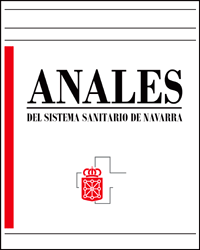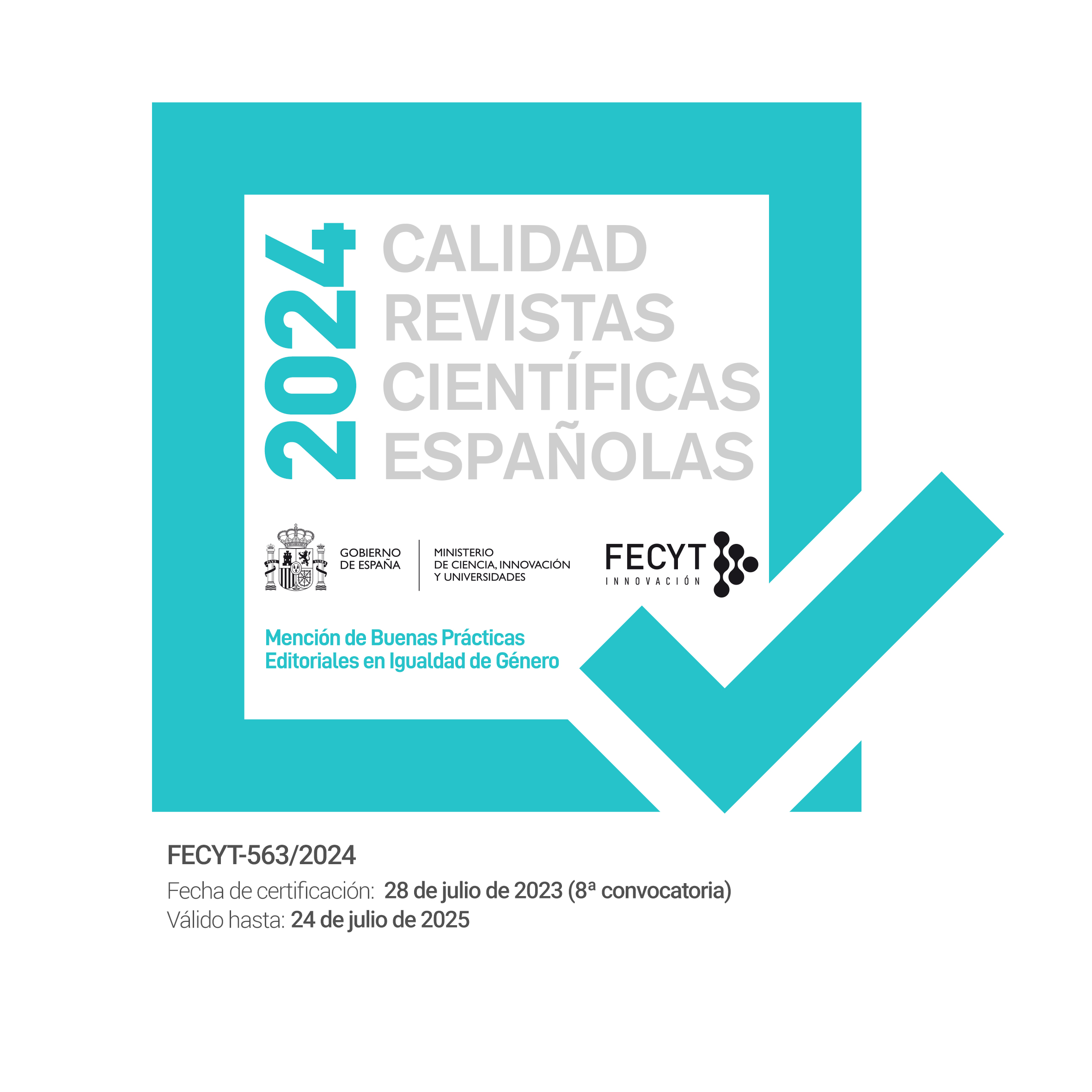Validación de la Escala sobre Habilidades de Comunicación
DOI:
https://doi.org/10.23938/ASSN.0745Palabras clave:
Comunicación. Personal de Enfermería. Psicometría.Resumen
Fundamento. La Escala sobre Habilidades de Comunicación (EHC) es un instrumento para evaluar las habilidades de comunicación en diferentes profesionales sanitarios; sin embargo, no se ha realizado ni un análisis diferencial de sus propiedades psicométricas por profesiones, ni baremos específicos. Por ello, el objetivo del presente estudio fue analizar las propiedades psicométricas de la EHC y elaborar un baremo en profesionales de Enfermería.
Material y Métodos. Estudio instrumental para analizar las propiedades psicométricas de la EHC, evaluándose los ítems, la fiabilidad, las evidencias de validez y su estructura interna. Para ello, se administró una batería de cuestionarios que incluía la EHC, la Escala de Autoeficacia General y la Escala de Autoeficacia Específica para la comunicación en situaciones difíciles.
Resultados. Los cuestionarios se aplicaron a 692 enfermeras. Se obtuvieron índices de discriminación >0,30 en todos los ítems. El análisis factorial confirmatorio de los dos modelos (de cuatro factores oblicuos y añadiendo un factor de segundo orden) reveló que todos los ítems tenían cargas factoriales adecuadas y que los índices de ajuste eran buenos. La consistencia interna fue de 0,88 para la escala total y entre 0,70 y 0,77 para las dimensiones. Se obtuvo una relación positiva entre las habilidades comunicativas y la autoeficacia general y específica.
Conclusiones. La EHC mostró unas adecuadas propiedades psicométricas en cuanto a análisis de ítems, estructura interna, fiabilidad y evidencias de validez, relacionando las habilidades de comunicación de las enfermeras con la autoeficacia general y específica para la comunicación en situaciones difíciles.
Descargas
Citas
. LANGBERG EM, DYHR L, DAVIDSEN AS. Development of the concept of patient-centredness - A systematic review. Patient Educ Couns 2019; 102: 1228-1236. https://doi.org/10.1016/j.pec.2019.02.023
SCHOLL I, ZILL JM, HÄRTER M, DIRMAIER J. An integrative model of patient-centeredness - A systematic review and concept analysis. PLoS One 2014; 9: e107828. https://doi.org/10.1371/journal.pone.0107828
STREET RL. Mapping diverse measures of patient-centered communication onto the conceptual domains of patient-centered care. Patient Educ Couns 2019; 102: 1225-1227. https://doi.org/10.1016/j.pec.2019.05.011
MEAD N, BOWER P. Patient-centredness: a conceptual framework and review of the empirical literature. Soc Sci Med 2000; 51: 1087-1110. https://doi.org/10.1016/s0277-9536(00)00098-8
MEAD N, BOWER P. Patient-centred consultations and outcomes in primary care: a review of the literature. Patient Educ Couns 2002; 48: 51-61. https://doi.org/10.1016/s0738-3991(02)00099-x
PEHRSON C, BANERJEE SC, MANNA R, JOHSON SHEN M, HAMMONDS S, COYLE N et al. Responding empathically to patients: Development, implementation, and evaluation of a communication skills training module for oncology nurses. Patient Educ Couns 2016; 99: 610-616. https://doi.org/10.1016/j.pec.2015.11.021
ARRANZ P, ULLA SM, RAMOS JL, DEL RINCÓN C, LÓPEZ-FANDO T. Evaluation of a counseling training program for nursing staff. Patient Educ Couns 2005; 56: 233-239. https://doi.org/10.1016/j.pec.2004.02.017
LEAL-COSTA C, DÍAZ-AGEA JL, TIRADO-GONZÁLEZ S, RODRÍGUEZ-MARÍN J, VAN-DER HOFSTADT CJ. Las habilidades de comunicación como factor preventivo del síndrome de Burnout en los profesionales de la salud. An Sist Sanit Navar 2015; 38: 213-223. https://doi.org/10.4321/s1137-66272015000200005
STREET RL. The many ‘disguises’ of patient-centered communication: Problems of conceptualization and measurement. Patient Educ Couns 2017; 100: 2131-2134. https://doi.org/10.1016/j.pec.2017.05.008
VARGAS C, CAÑADAS GA, AGUAYO R, FERNÁNDEZ R, DE LA FUENTE EI. Which occupational risk factors are associated with burnout in nursing? A meta-analytic study. Int J Clin Health Psychol 2014; 14: 28-38. https://doi.org/10.1016/s1697-2600(14)70034-1
GAVILÁN MORAL E, RUIZ MORAL R, PERULA DE TORRES LÁ, PARRAS REJANO JM. Valoración de la relación clínica centrada en el paciente: análisis de las propiedades psicométricas de la escala CICAA. Aten Primaria 2010; 42: 162-168. https://doi.org/10.1016/j.aprim.2009.07.005
LEAL COSTA C, GÓMEZ SÁNCHEZ R, TIRADO GONZÁLEZ S, RODRÍGUEZ MARÍN J, VAN-DER HOFSTADT ROMÁN CJ. Psychometric properties of the spanish adaptation of the Health Care Communication Questionnaire (HCCQ). Span J Psychol 2015; 18: E96. https://doi.org/10.1017/sjp.2015.90
RUIZ MORAL R, PRADOS CASTILLEJO JA, ALBA JURADO M, BELLÓN SAAMEÑO J, PÉRULA DE TORRES LA. Validez y fiabilidad de un instrumento para la valoración de la entrevista clínica en médicos residentes de medicina de familia: el cuestionario GATHA-RES. Aten Primaria 2001; 27: 469-477. https://doi.org/10.1016/s0212-6567(01)78837-3
American Educational Research Association, American Psychological Association, National Council on Measurement in Education. Standards for educational and psychological testing (2014). Washington: American Educational Research Association; 2014. https://doi.org/10.2307/j.ctvr43hg2
CARRETERO DIOS H, PÉREZ MELÉNDEZ C. Normas para el desarrollo y revisión de estudios instrumentales. Int J Clin Health Psychol 2005; 5: 521-551.
CARRETERO DIOS H, PÉREZ MELÉNDEZ C. Standards for the development and review of instrumental studies: considerations about test selection in psychological research. Int J Clin Health Psychol 2007; 7: 863-882.
LEAL-COSTA C, TIRADO-GONZÁLEZ S, RODRÍGUEZ-MARÍN J, VAN-DER HOFSTADT ROMÁN CJ. Creación de la Escala sobre Habilidades de comunicación en Profesionales de la Salud, EHC-PS. Anal Psicol 2016; 32: 49-59. https://doi.org/10.6018/analesps.32.1.184701
LEAL-COSTA C, TIRADO-GONZÁLEZ S, RODRÍGUEZ-MARÍN J, VANDER-HOFSTADT-ROMÁN CJ. Psychometric properties of the Health Professionals Communication Skills Scale (HP-CSS). Int J Clin Health Psychol 2016; 16: 76-86. https://doi.org/10.1016/j.ijchp.2015.04.001
BANDURA A. Self-efficacy: toward a unifying theory of behavioral change. Adv Behav Res Ther 1978; 1: 139-161. https://doi.org/10.1016/0146-6402(78)90002-4
AMMENTORP J, SABROE S, KOFOED P-E, MAINZ J. The effect of training in communication skills on medical doctors’ and nurses’ self-efficacy. A randomized controlled trial. Patient Educ Couns 2007; 66: 270-277. https://doi.org/10.1016/j.pec.2006.12.012
DOYLE D, COPELAND HL, BUSH D, STEIN L, THOMPSON S. A course for nurses to handle difficult communication situations. A randomized controlled trial of impact on self-efficacy and performance. Patient Educ Couns 2011; 82: 100-109. https://doi.org/10.1016/j.pec.2010.02.013
PARLE M, MAGUIRE P, HEAVEN C. The development of a training model to improve health professionals’ skills, self-efficacy and outcome expectancies when communicating with cancer patients. Soc Sci Med 1997; 44: 231-240. https://doi.org/10.1016/s0277-9536(96)00148-7
NØRGAARD B, AMMENTORP J, KYVIK KO, KOFOED P-E. Communication skills training increases self-efficacy of health care professionals. J Contin Educ Health Prof 2012; 32: 90-97. https://doi.org/10.1002/chp.21131
PARK MS, JEOUNG Y, LEE HK, SOK SR. Relationships among communication competence, self-efficacy, and job satisfaction in Korean nurses working in the emergency medical center setting. J Nurs Res 2015; 23: 101-108. https://doi.org/10.1097/jnr.0000000000000059
ARAUJO LUGO MV, SOLÍS MARÍN KE. Habilidades de comunicación efectiva y su relación, con la presencia de síndrome de burnout en médicos postgradistas de áreas clínicas y quirúrgicas de la Pontificia Universidad Católica del Ecuador, en el período 2012 – 2016. Tesis de postgrado en Medicina Familiar y Comunitaria. Pontificia Universidad Católica del Ecuador. Quito, 5 de octubre de 2017. http://repositorio.puce.edu.ec/handle/22000/13731
FERNÁNDEZ-QUIROGA MR, YÉVENES V, GÓMEZ D, VILLARROEL E, FERNÁNDEZ-QUIROGA MR, YÉVENES V et al. Uso de la simulación clínica como estrategia de aprendizaje para el desarrollo de habilidades comunicacionales en estudiantes de medicina. Rev Fund Educ Med 2017; 20: 301-304. https://doi.org/10.33588/fem.206.921
SANJUÁN SUÁREZ P, GARCÍA PÉREZ AM, MORENO BERMÚDEZ J. Escala de Autoeficacia General: datos psicométricos de la adaptación para población española. Psicothema 2000; 12 (Suppl 2): 509-513.
STREINER DL, NORMAN GR, CAIRNEY J. Health measurement scales: a practical guide to their development and use. 3ª ed. New York: Oxford University Press; 2015.
HU L, BENTLER PM. Cutoff criteria for fit indexes in covariance structure analysis: Conventional criteria versus new alternatives. Struct Equ Modeling 1999; 6: 1-55. https://doi.org/10.1080/10705519909540118
ARIAS RM. Psicometría: teoría de los tests psicológicos y educativos. Madrid: Síntesis; 1996.
NUNNALLY JC, BERNSTEIN IH. Psychometric theory. 3ª ed. Madrid: McGraw-Hill; 1994.
LLORET-SEGURA S, FERRERES-TRAVER A, HERNÁNDEZ-BAEZA A, TOMÁS-MARCO I. El análisis factorial exploratorio de los ítems: una guía práctica, revisada y actualizada. Anal Psicol 2014; 30: 1151-1169. https://doi.org/10.6018/analesps.30.3.199361
BROWN TA. Confirmatory factor analysis for applied research. New York: Guilford Press; 2006.
KLINE RB. Principles and practice of structural equation modeling 3ª ed. New York: Guilford Publications; 2011.
BYRNE BM. Choosing structural equation modeling computer software: Snapshots of LISREL, EQS, Amos, and Mplus. En: Rick HH, editor. Handbook of structural equation modeling. New York: Guilford Press; 2012: 307-324.
MORALES VALLEJO P. Medición de actitudes en psicología y educación: construcción de escalas y problemas metodológicos 3ª ed. Madrid: Universidad Pontifica de Comillas; 2006.
EVERS A, MUÑIZ J, HAGEMEISTER C, HØTMÆLINGEN A, LINDLEY P, SJÖBERGR A et al. Assessing the quality of tests: revision of the EFPA review model. Psicothema 2013; 25: 283-291.
Publicado
Cómo citar
Número
Sección
Licencia
Derechos de autor 2019 Anales del Sistema Sanitario de Navarra

Esta obra está bajo una licencia internacional Creative Commons Atribución-CompartirIgual 4.0.
La revista Anales del Sistema Sanitario de Navarra es publicada por el Departamento de Salud del Gobierno de Navarra (España), quien conserva los derechos patrimoniales (copyright ) sobre el artículo publicado y favorece y permite la difusión del mismo bajo licencia Creative Commons Reconocimiento-CompartirIgual 4.0 Internacional (CC BY-SA 4.0). Esta licencia permite copiar, usar, difundir, transmitir y exponer públicamente el artículo, siempre que siempre que se cite la autoría y la publicación inicial en Anales del Sistema Sanitario de Navarra, y se distinga la existencia de esta licencia de uso.








